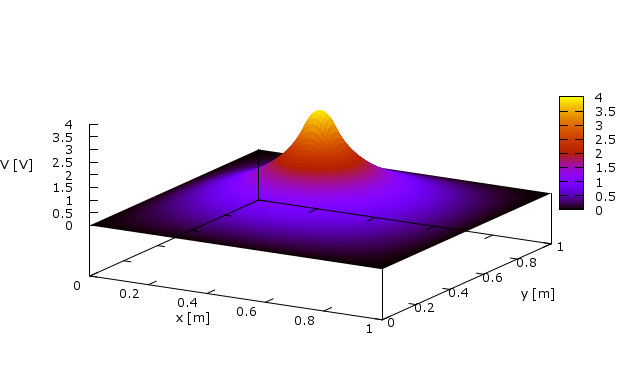前回のエントリ(d:id:hecomi:20100717:1279390033)では1次元のポアソン方程式を解いたので2次元を解いてみようと思います.理論は2次元になっただけでほぼ同じです.
2次元ポアソン方程式計算
poisson.h
#include <vector> #include <iostream> #include <cmath> #include <boost/multi_array.hpp> /* @brief 2次元ポアソン方程式をSOR法により計算する(ディリクレ条件) @param[out] V 対称のポテンシャルベクトル @param[in] x 対応する位置のベクトル @param[in] y 対応する位置のベクトル @param[in] RhoOverEPS 電荷分布を表すファンクタ @param[in] minErr 収束最小値 @param[in] maxStep 最大計算ループ数 @param[in] w SOR法係数 */ template <class Container, class Functor> int solvePoisson2D(boost::multi_array<double, 2> &V, const Container &x, const Container &y, Functor RhoOverEps, const double minErr = 1e-5, const double maxStep = 1000, const double w = 1.9) { using namespace std; // vectorサイズ一致の確認 const int divX = x.size(); const int divY = y.size(); const int divZ = V.shape()[0] * V.shape()[1]; if (divZ != divX*divY) { cout << "V.size() != x.size()*y.size() @solvePoisson2D" << endl; return false; } // vector最小数 if (divX < 3 || divY < 3) { cout << "x.size() or y.size() < 3 @solvePoisson2D" << endl; return false; } // 単調増加か for (int i=0; i<divX-1; i++) { if (x[i] > x[i+1]) { std::cout << "Error! x must be monotonically increasing. (@solvePoisson2D)" << std::endl; return false; } } for (int j=0; j<divX-1; j++) { if (y[j] > y[j+1]) { std::cout << "Error! y must be monotonically increasing. (@solvePoisson2D)" << std::endl; return false; } } // 微分幅を得る const double dx = x[1] - x[0]; const double dy = y[1] - y[0]; // 誤差初期値 double err = 2*minErr; // ループ回数 int step = 0; // 誤差が最小誤差よりも小さくなるか,maxStepに到達するまでセルフコンシステント計算 double Vmax = 0.0; while (err > minErr && step++ < maxStep) { err = 0; // 差分法を適用 for (int i=1; i < divX-1; i++) { for (int j=1; j < divY-1; j++) { double Vp = V[i][j]; // Poisson方程式 V[i][j] = Vp + w * ( 1/(2*(dx*dx + dy*dy)) * ( (dx*dx*dy*dy) * RhoOverEps(x[i], y[j]) + dx*dx*(V[i][j-1] + V[i][j+1]) + dy*dy*(V[i-1][j] + V[i+1][j]) ) - V[i][j] ); // 規格化用Vを計算 if (fabs(V[i][j]) > Vmax) { Vmax = fabs(V[i][j]); } // 誤差計算 double dif = abs(V[i][j] - Vp)/Vmax; if (dif > err) { err = dif; } } } } if (step >= maxStep) { cout << "Poisson's equation did not converge." << endl; } else { cout << "Poisson's equation converged." << endl; } cout << "step: " << step << endl; cout << "err: " << err << endl; return true; }
main.cpp
#define USE_BOOST // boostの使用(gnuplot.h) #include "calc.h" #include "poisson.h" #include "gnuplot.h" using namespace calc; using namespace std; int main() { // 物理定数 const double eps = 8.85418782e-12; // 分割数 const int N = 100; // 計算用ベクトル vector<double> x, y; boost::multi_array<double, 2> V(boost::extents[N+1][N+1]); // x, yベクトル作成(0〜1[m]) makeVector(x, 0.0, 1.0, N); makeVector(y, 0.0, 1.0, N); // Vベクトル作成(境界条件はディリクレ,端は0 [V]) setVector(V, x, y, _1*0); // 電荷分布作成(中心に10[cm]幅) const double q = 1e-8; boost::function<double(double, double)> roe = if_then_else_return( bind(fabs, (_1-0.5)*(_1-0.5) + (_2-0.5)*(_2-0.5)) < 0.05*0.05, q/eps, 0.0 ); // ポアソン方程式を解く solvePoisson2D(V, x, y, roe); CGnuplot gp; gp.Plot(x, y, V); gp.SetLabel("x [m]", "y [m]"); gp.Command("set zlabel 'V [V]'"); gp.Replot(); gp.DumpToPng("poisson"); // 待ち int num; cin >> num; }
参考文献
計算結果の比較に使わさせて頂きました.このブログを見るより,100倍分かりやすいと思います.
